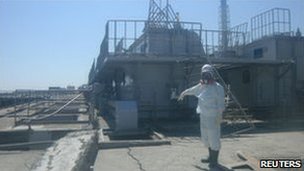 A leak of highly radioactive water into the Pacific Ocean from Japan's crippled Fukushima Daiichi nuclear plant has been stopped, its operator reports.
A leak of highly radioactive water into the Pacific Ocean from Japan's crippled Fukushima Daiichi nuclear plant has been stopped, its operator reports.Tepco said it had injected chemical agents to solidify soil near a cracked pit that was the source of the leak.
Engineers have been struggling to stop leaks since the plant was damaged by the earthquake and tsunami on 11 March.
They are currently discharging less contaminated water into the sea so more radioactive water can be stored.
Since the earthquake knocked out cooling systems workers have been pumping water into reactors to cool fuel rods, but must now deal with waste water pooling in and below damaged reactor buildings.
Engineers also face a potential new problem of a build-up of hydrogen gas in one of the reactors at the six-unit plant. Tepco said it could inject nitrogen gas into the No 1 reactor to prevent an explosion.
Blasts caused by a build-up of hydrogen gas took place in three reactors in the aftermath of the earthquake.
'Water glass'
Plugging the leak from the pit in the No 2 reactor represents a measure of success for engineers at the plant, analysts say.
It is thought to have been the source of high levels of radiation found in seawater close to the plant.
In order to stem the leak, Tepco (the Tokyo Electric Power Co) injected ''water glass'', or sodium silicate, and another agent into the pit.
Desperate engineers had also used sawdust, newspapers and concrete in recent days to try to stop the escaping water.
The government's top spokesman said workers could not rule out other leaks at the reactor.
"Right now, just because the leak has stopped, we are not relieved yet," said Chief Cabinet Secretary Yukio Edano. "We are checking whether the leak has completely stopped, or whether there may be other leaks."
Meanwhile, engineers are continuing to pump some 11,500 tonnes of low-level radioactive seawater into the sea so the more highly contaminated water can be stored in waste buildings.
Officials said this water would not pose a significant threat to human health, but local fishermen have reacted angrily.
In a letter, the largest fisheries group accused the government of an "utterly outrageous" action that threatened livelihoods.
On Tuesday, elevated levels of iodine - about twice the legal limit for vegetables - were found in launce (a small fish) caught off Ibaraki prefecture to the south of Fukushima.
On Tuesday, Japan asked Russia for the use of a floating radiation treatment plant to tackle waste water.
Russia's nuclear agency Rosatom said it was awaiting answers to some questions before granting the request to lend the Landysh, known in Japanese as the Suzuran, which is used to decommission Russian nuclear submarines in the far eastern port of Vladivostok.
One of the world's largest liquid radioactive waste treatment plants, the Landysh treats radioactive liquid with chemicals and stores it in a cement form.



